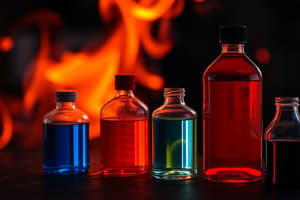Podcast
Questions and Answers
What devices can be used to dispose of flammable and combustible liquids?
What devices can be used to dispose of flammable and combustible liquids?
- Safety disposal cans (correct)
- Waste drums (correct)
- Fire flashbacks
- Portable extinguishers
What items are required to appear on the label for a flammable or combustible liquid?
What items are required to appear on the label for a flammable or combustible liquid?
- Storage temperature
- GHS flammability rating (correct)
- Manufacturer name
- Flash point (correct)
What storage method does OSHA require in any facility that stores more than 25 gallons of flammable or combustible liquids?
What storage method does OSHA require in any facility that stores more than 25 gallons of flammable or combustible liquids?
- Open storage
- Safety can
- Containerized storage
- Flammable storage room (correct)
Which statement about fire control is true? Water used to fight fires can react violently with some chemicals.
Which statement about fire control is true? Water used to fight fires can react violently with some chemicals.
What are companies expected to do to prevent hazards from flammable and combustible liquids?
What are companies expected to do to prevent hazards from flammable and combustible liquids?
What statement accurately describes a flammable and combustible liquid safety plan?
What statement accurately describes a flammable and combustible liquid safety plan?
Which categories of flammable liquids are considered the most dangerous, as they can ignite at the lowest flash point of under 73.4°F (23°C)?
Which categories of flammable liquids are considered the most dangerous, as they can ignite at the lowest flash point of under 73.4°F (23°C)?
What features of a closed piping system reduce the fire risk involved with flammable and combustible liquids?
What features of a closed piping system reduce the fire risk involved with flammable and combustible liquids?
Which characteristic describes a flammable liquid?
Which characteristic describes a flammable liquid?
How can fires be prevented?
How can fires be prevented?
Which statement best describes requirements for information about flammable and combustible liquids?
Which statement best describes requirements for information about flammable and combustible liquids?
TRUE/FALSE: Flammable liquid categories consider the boiling point of a liquid.
TRUE/FALSE: Flammable liquid categories consider the boiling point of a liquid.
TRUE/FALSE: Flash point is the minimum temperature at which a liquid has the potential to ignite.
TRUE/FALSE: Flash point is the minimum temperature at which a liquid has the potential to ignite.
TRUE/FALSE: Flammable liquids are organized into two categories and two sub-categories.
TRUE/FALSE: Flammable liquids are organized into two categories and two sub-categories.
TRUE/FALSE: Combustible liquids have a flash point from 50°F (10°C) to 80°F (26.7°C).
TRUE/FALSE: Combustible liquids have a flash point from 50°F (10°C) to 80°F (26.7°C).
Which of the following statements about static electricity is true?
Which of the following statements about static electricity is true?
Which of the following provides internationally standardized flammability ratings?
Which of the following provides internationally standardized flammability ratings?
Why is grounding important?
Why is grounding important?
Which of the following is a document providing information on flammable and combustible fluids?
Which of the following is a document providing information on flammable and combustible fluids?
What term is used to describe welding sparks, lightning, and static electricity in a flammable liquids safety plan?
What term is used to describe welding sparks, lightning, and static electricity in a flammable liquids safety plan?
What are the key features of storage cabinets for flammable liquids?
What are the key features of storage cabinets for flammable liquids?
What facts are true about safety cans?
What facts are true about safety cans?
What must be included in a storage room for flammable liquids?
What must be included in a storage room for flammable liquids?
What does the safety venting mechanism and flame arresters in storage and safety disposal cans prevent?
What does the safety venting mechanism and flame arresters in storage and safety disposal cans prevent?
What do bonding and grounding wires prevent from building up?
What do bonding and grounding wires prevent from building up?
What determines whether a fluid is flammable or combustible, as well as its category or class?
What determines whether a fluid is flammable or combustible, as well as its category or class?
What must contain fluid names, risks, and how to handle its hazards?
What must contain fluid names, risks, and how to handle its hazards?
In addition to oxygen and heat, what must be present in order for a fire to start?
In addition to oxygen and heat, what must be present in order for a fire to start?
What happens when some chemicals contact water or the incorrect fire extinguisher is used on a fire?
What happens when some chemicals contact water or the incorrect fire extinguisher is used on a fire?
What OSHA requirement includes strategies for controlling ignition sources and fires, storing and handling flammable and combustible liquids, and conducting employee training and hazard communication?
What OSHA requirement includes strategies for controlling ignition sources and fires, storing and handling flammable and combustible liquids, and conducting employee training and hazard communication?
Which of the following flammable liquid storage options should include a three-point lock system?
Which of the following flammable liquid storage options should include a three-point lock system?
What flammable waste disposal method features an elevated base, as well as a self-closing lid that opens only 60 degrees to limit oxygen exposure?
What flammable waste disposal method features an elevated base, as well as a self-closing lid that opens only 60 degrees to limit oxygen exposure?
According to OSHA, what is a fundamental step in storing flammable and combustible liquids safely?
According to OSHA, what is a fundamental step in storing flammable and combustible liquids safely?
In order for a fire to occur, which components must combine with heat?
In order for a fire to occur, which components must combine with heat?
Which component of a safety can dissipates heat to prevent fire flashback?
Which component of a safety can dissipates heat to prevent fire flashback?
What information source must include a flammable or combustible liquid's name, manufacturer, hazards and risks, ingredients, and methods of handling accidents?
What information source must include a flammable or combustible liquid's name, manufacturer, hazards and risks, ingredients, and methods of handling accidents?
Who is responsible for providing training on the proper handling and storage of flammable/combustible liquids?
Who is responsible for providing training on the proper handling and storage of flammable/combustible liquids?
Which of the following devices may be used for fighting incipient stage fires in the workplace?
Which of the following devices may be used for fighting incipient stage fires in the workplace?
What does grounding prevent?
What does grounding prevent?
Which class of combustible liquids should be considered the most dangerous, and has the lowest flash point?
Which class of combustible liquids should be considered the most dangerous, and has the lowest flash point?
What organization standardizes the numerical flammability rating that must appear on all flammable and combustible liquid labels?
What organization standardizes the numerical flammability rating that must appear on all flammable and combustible liquid labels?
Which statement is true regarding OSHA-approved flammable storage rooms?
Which statement is true regarding OSHA-approved flammable storage rooms?
What two devices are often used with a bonding wire to transfer flammable and combustible liquids from storage drums to portable containers?
What two devices are often used with a bonding wire to transfer flammable and combustible liquids from storage drums to portable containers?
What hazard can be caused by a flammable liquid at or above its flash point moving through a pipe or opening?
What hazard can be caused by a flammable liquid at or above its flash point moving through a pipe or opening?
Which category of flammable liquids can be considered the least flammable, with a flash point between 140 and 200°F (60-93°C)?
Which category of flammable liquids can be considered the least flammable, with a flash point between 140 and 200°F (60-93°C)?
According to OSHA, what would be the safest way to store flammable liquids?
According to OSHA, what would be the safest way to store flammable liquids?
Flashcards are hidden until you start studying
Study Notes
Flammable and Combustible Liquids Overview
- Flammable Liquids: Ignite easily with flash points below 100°F (38°C).
- Combustible Liquids: Require higher temperatures to ignite, flash point above 100°F (37.8°C).
Key Terms and Definitions
- Boiling Point: Temperature where a liquid transitions to vapor; important for categorizing flammable liquids.
- Flash Point: Lowest temperature at which a liquid generates ignitable vapors; crucial for assessing fire risk.
- Bonding: Connecting two electrically conductive objects to equalize static charges; often done during liquid transfers.
- Grounding: Connecting a conductive object to the ground to dissipate static electricity.
Categories of Flammable and Combustible Liquids
- Category 1 Liquids: Flash point <73.4°F (23°C) and boiling point ≤ 95°F (35°C).
- Category 2 Liquids: Flash point <73.4°F (23°C) and boiling point > 95°F (35°C).
- Category 3 Liquids: Flash point ≥73.4°F (23°C) and boiling point ≤ 140°F (60°C).
- Category 4 Liquids: Flash point ≥140°F (60°C) and boiling point ≤ 200°F (93°C).
Classes of Combustible Liquids
- Class II: Flash point between 100°F (37.8°C) and 140°F (60°C); most dangerous class of combustible liquids.
- Class III: Flash point ≥140°F (60°C); includes subclasses IIIA (140°F to 200°F) and IIIB (≥200°F).
Safety Measures and Equipment
- Closed Piping Systems: Minimize airflow and vapor formation, reducing fire risks during liquid transport.
- Safety Cans: Hold 1-5 gallons of liquid; must include safety features like venting and flame arresters.
- Storage Cabinets: Must have a three-point locking mechanism, labeled, and designed to store flammable materials safely.
Regulations and Compliance
- OSHA Standards: Mandate that facilities storing over 25 gallons of flammable liquids must have approved storage rooms equipped with ventilation.
- Safety Data Sheets (SDS): Provide crucial information on hazards, risks, and handling for flammable liquids; required in workplace settings.
Fire Control and Prevention
- Ignition Sources: Include sparks, open flames, and hot surfaces; essential to manage to prevent fires.
- Fire Prevention: Involves storing flammable liquids away from heat sources and ensuring proper container labeling.
- Control Mechanisms: Safety vents help prevent explosion risks by releasing pressure build-up in containers.
Important Practices to Follow
- Disposal Methods: Use waste drums and safety disposal cans specifically designed for flammable substances.
- Employee Training: Employers are responsible for educating workers on safe handling and storage practices of flammable and combustible liquids.
- Hazard Communication: Involves informing employees about potential risks and ensuring proper labeling is visible on all containers.
Key Challenges and Considerations
- Chemical Reactions: Certain chemicals can react violently with water; proper extinguishing methods must be identified.
- Static Electricity: A significant ignition source; bonding and grounding can help mitigate risks.
Studying That Suits You
Use AI to generate personalized quizzes and flashcards to suit your learning preferences.




